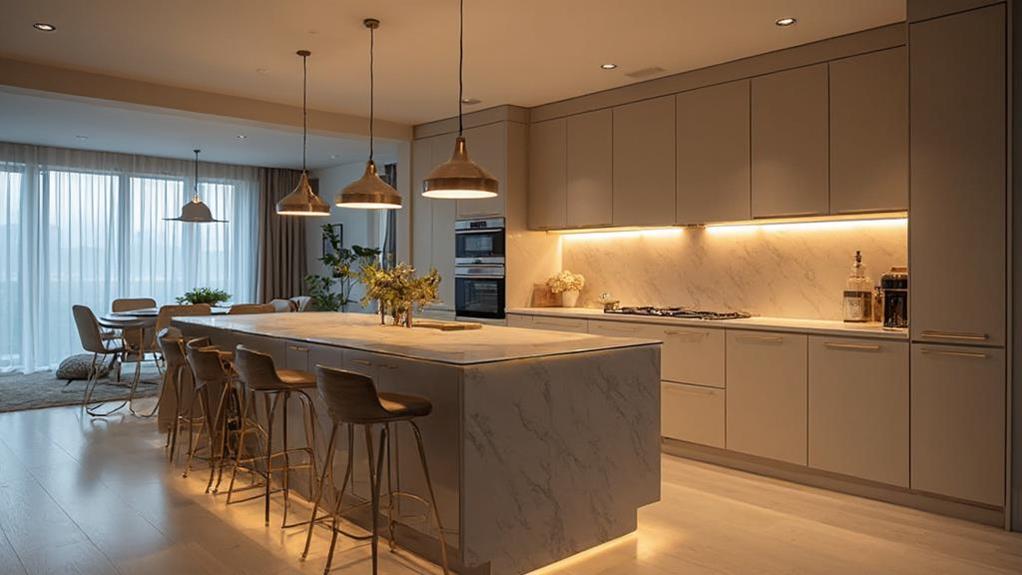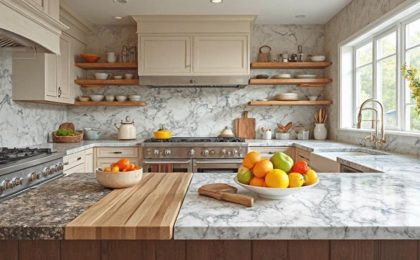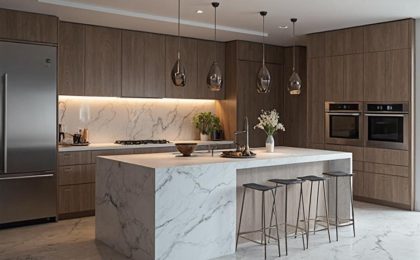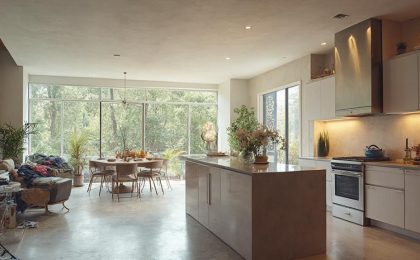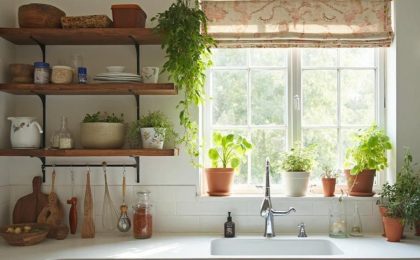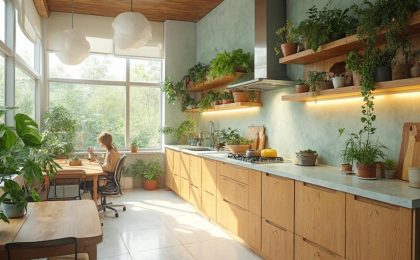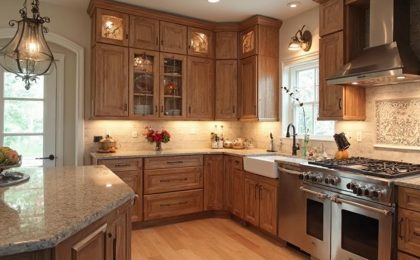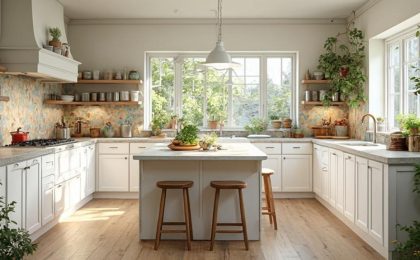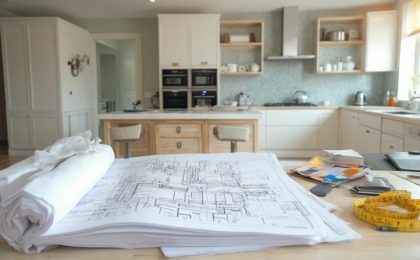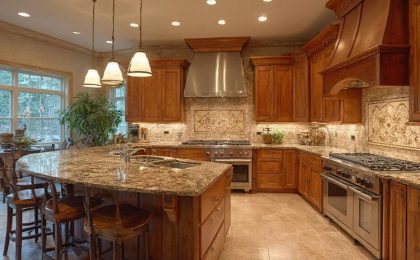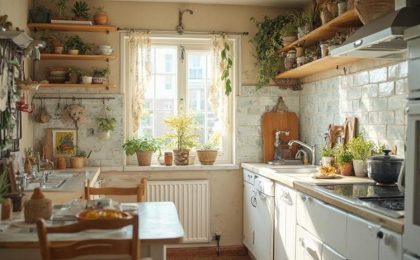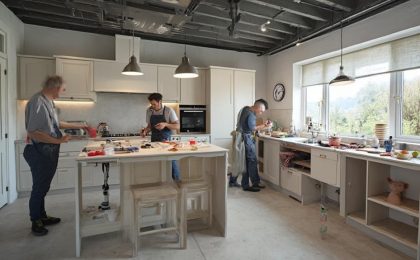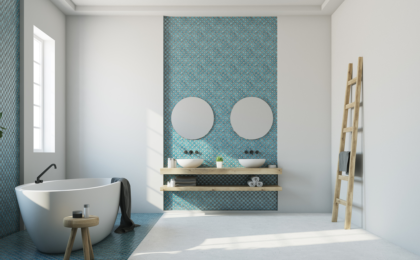When you think about kitchen design, lighting often takes a backseat, but it shouldn't. The right lighting can enhance both functionality and mood, making your kitchen a more enjoyable space. By understanding the different types of lighting—ambient, task, and accent—you can create a layered approach that not only illuminates but also highlights your kitchen's best features. Curious about how to strategically place fixtures or choose the right color temperature? Let's explore some bright ideas that can transform your kitchen into a well-lit haven.
Key insights
- Effective kitchen lighting enhances functionality and creates a warm, inviting atmosphere for cooking and gathering.
- Combining ambient, task, and accent lighting provides layered illumination, ensuring all areas are well-lit and visually appealing.
- Strategic placement of fixtures, such as under-cabinet lights and pendants, maximizes workspace efficiency while minimizing shadows.
- Choosing the right color temperature influences mood; warmer tones foster coziness while cooler tones enhance visibility in task areas.
- Energy-efficient lighting options, like LED bulbs and smart controls, contribute to sustainability while elevating the kitchen's aesthetics.
Importance of Kitchen Lighting
When it comes to kitchen design, effective lighting is absolutely essential for creating a functional and inviting space. You'll want to harness natural light whenever possible, allowing sunlight to stream through windows and brighten up your culinary haven. This not only enhances the mood but also makes the kitchen feel more spacious and connected to the outdoors.
Additionally, hiring local experts can help guarantee that your lighting choices align with the architectural style of your home in Leeds.
As you explore current lighting trends, consider incorporating a mix of ambient, task, and accent lighting. Layering these types will guarantee you have the right illumination for every activity, whether you're chopping vegetables or entertaining friends.
Pendant lights over an island can serve as both a focal point and a source of task lighting, while under-cabinet fixtures illuminate countertops without overwhelming the room.
Additionally, think about the color temperature of your light sources. Warmer tones create a cozy atmosphere, perfect for family gatherings, while cooler tones may be ideal for a more modern, sleek look.
Types of Kitchen Lighting
Though you might think of kitchen lighting as just functional, it actually encompasses a variety of styles and purposes that can elevate your space. Consider pendant styles that hang gracefully over your island, offering both illumination and a decorative touch.
For a sleek look, under cabinet options can effectively highlight your countertops while maintaining an uncluttered appearance. Additionally, using high-quality fixtures, similar to those recommended by professional bathroom fitters, can enhance both the aesthetics and functionality of your kitchen lighting.
Chandelier choices add a touch of elegance, making your dining area feel inviting and warm. Recessed designs create a clean ceiling line, providing an unobtrusive way to brighten up the entire kitchen.
If you're looking for versatility, track lighting allows you to direct beams where you need them most, adapting to your changing needs.
Incorporating dimmer switches gives you control over ambiance, letting you shift from bright task lighting to softer, mood-enhancing illumination with ease. Embrace lighting trends that incorporate fixture materials like brushed metal or glass for a modern flair.
Don't forget the importance of natural light—large windows can beautifully complement your artificial sources. Finally, smart lighting solutions can revolutionize your kitchen experience, allowing you to adjust settings right from your smartphone.
Task Lighting Essentials
Task lighting is essential in any kitchen, ensuring that you have the right illumination exactly where you need it most. Effective task lighting placement is vital for maximizing your workspace, allowing you to chop vegetables, read recipes, and clean with ease. For best results, consider positioning your task lighting fixtures directly above key areas like countertops, sinks, and stovetops.
Incorporating quality workmanship, similar to what you'd expect from professional tile fitters, can enhance the overall aesthetic and functionality of your kitchen space, making it a joy to work in. Quality craftsmanship is key to ensuring that your kitchen not only looks great but also meets your practical needs.
Under-cabinet lighting is a popular choice, providing a bright glow that minimizes shadows and enhances visibility. LED strip lights can be a sleek, energy-efficient option that seamlessly integrates into your kitchen design.
Pendant lights hanging above an island not only serve as stylish décor but also offer targeted illumination for food prep or casual dining.
Don't overlook the importance of adjustable fixtures; they allow you to direct light precisely where it's needed, making cooking and cleaning tasks more efficient. Aim for a combination of different task lighting fixtures to create a layered effect, ensuring every nook of your kitchen is well-lit.
Ultimately, the right task lighting transforms your kitchen into a functional space, enhancing both your culinary skills and your enjoyment of cooking.
Ambient Lighting Solutions
Ambient lighting sets the mood in your kitchen, creating a warm and inviting atmosphere for both cooking and gathering.
To achieve the perfect ambiance, consider these three key elements:
1. Natural Light: Maximize the use of windows and skylights. Natural light not only enhances the space but also makes your kitchen feel larger and more welcoming.
Strategically placed mirrors can also reflect light, brightening up dark corners.
2. Layered Lighting: Combine various ambient light sources to create depth. Use ceiling fixtures, wall sconces, or even pendant lights to distribute light evenly across the room.
This approach aligns with current lighting trends, promoting versatility and functionality.
3. Dimming Options: Incorporate dimmers to adjust the brightness based on the time of day or activity.
Whether you're hosting a dinner party or enjoying a quiet breakfast, having control over the light intensity allows you to tailor the atmosphere to your needs.
Accent Lighting Techniques
Accent lighting techniques are often overlooked, yet they play an essential role in highlighting specific areas and features of your kitchen. By using these techniques, you can create visual interest and depth, making your space feel more inviting.
Start by considering sconce styles; wall-mounted sconces can frame your artwork or cabinetry beautifully. Position them at eye level to emphasize their design while casting a warm glow.
Next, think about pendant placement. Hang pendants over your kitchen island or dining area to draw attention to these focal points. Choose fixtures that complement your overall décor while offering a striking contrast. For a more dynamic effect, vary the heights of the pendants, creating layers of light that guide the eye through the space.
Don't forget about under-cabinet lighting! Installing LED strips underneath your cabinets can illuminate your countertops, making meal prep safer and more enjoyable. This technique not only serves a practical purpose but also adds a soft glow that highlights your kitchen's textures and finishes.
Choosing the Right Fixtures
When it comes to enhancing your kitchen's atmosphere, selecting the right fixtures is key to achieving both functionality and style. The right lighting can transform your space, making it not only more inviting but also more efficient for cooking and entertaining.
Consider these essential factors when choosing your fixtures:
1. Fixture Styles: Think about the overall design of your kitchen. Whether you prefer modern, rustic, or industrial looks, your fixtures should complement your cabinetry and countertops.
Pendant lights over an island can add a trendy touch, while classic chandeliers may enhance a traditional space.
2. Fixture Materials: Opt for materials that reflect your kitchen's character. Metal, glass, and even wood can be used to create stunning focal points.
Stainless steel is durable and sleek, while glass can add an element of elegance.
3. Size and Scale: Guarantee your fixtures fit proportionately within your space. Oversized fixtures can overwhelm a small kitchen, while tiny lights can get lost in a vast area.
Layering Light for Effect
Creating a well-lit kitchen involves more than just installing a single overhead light; it requires a thoughtful approach to layering different types of lighting. By combining ambient, task, and accent lighting, you can achieve both functionality and aesthetic appeal in your space.
Start with ambient lighting to provide a base layer, ensuring your kitchen feels welcoming and bright. For task lighting, focus on areas where you prepare food or perform other activities—under-cabinet lights work wonders here, illuminating countertops and enhancing the textures of your surfaces.
Accent lighting adds drama and depth, drawing attention to your favorite design elements, like a beautiful backsplash or decorative shelf. By strategically placing pendant lights or wall sconces, you create visual interest while enhancing the overall mood of the kitchen.
Consider the effect of each type of lighting; they work together to transform your kitchen into a dynamic space. By layering these various lighting textures, you not only improve functionality but also elevate the atmosphere, creating a kitchen that's perfect for both cooking and entertaining.
Your attention to detail in lighting will make all the difference.
Color Temperature Considerations
Choosing the right color temperature for your kitchen lighting can greatly influence the room's overall ambiance and functionality. Understanding how color temperature impacts your kitchen can help you create the perfect atmosphere.
You'll want to take into account the following aspects when deciding between warm vs cool lighting:
- Activity Zones: For task areas like countertops, cooler temperatures (above 4000K) enhance visibility and focus, making it easier to chop vegetables or read recipes.
- Comfort Levels: Warmer lights (below 3000K) evoke a cozy, inviting feel, perfect for gathering spaces where family and friends congregate. This warmth adds a sense of comfort, making the kitchen the heart of your home.
- Color Rendering: Higher color temperatures can distort colors, while warmer lights provide a truer representation, especially critical when plating food or showcasing fresh ingredients.
Energy Efficiency in Lighting
As you consider the color temperature of your kitchen lighting, energy efficiency becomes another essential factor in your design choices.
Opting for LED options is one of the best ways to achieve significant energy savings while enhancing light quality. LED bulbs not only last longer than traditional incandescent lights but also consume a fraction of the energy, making them a sustainable choice for your home.
Integrating smart controls into your lighting design can further amplify your energy efficiency. With smart dimmers and timers, you can adjust the brightness based on your needs, ensuring you're not wasting energy when natural light floods your kitchen during the day.
These controls can help you create a dynamic atmosphere while promoting sustainability practices at home.
Additionally, consider maximizing natural light by positioning windows or skylights strategically, reducing the need for artificial lighting during the day.
This approach not only conserves energy but also enhances the overall environment of your space.
Balancing aesthetic appeal with energy-efficient choices will lead to a kitchen that's both beautiful and eco-friendly, proving that you can prioritize sustainability without sacrificing style.
Tips for Installation and Placement
When planning your kitchen lighting, consider the layout and functionality of the space to guarantee ideal placement. Proper installation guarantees you create an inviting atmosphere while enhancing your kitchen's efficiency.
Focus on defining your lighting zones—areas that require specific illumination based on their use.
Here are three essential tips to guide you:
- Determine Fixture Heights: Pendant lights should hang approximately 30-36 inches above your countertops, while recessed lighting should be spaced 4-6 feet apart. This prevents shadows and guarantees adequate visibility.
- Layer Your Lighting: Incorporate ambient, task, and accent lighting to create depth. Use ceiling fixtures for general illumination, under-cabinet lights for task areas, and decorative fixtures to highlight your design features.
- Consider Dimming Options: Installing dimmers allows you to adjust brightness based on the time of day or activity. This flexibility can transform your kitchen from a bustling workspace to a cozy gathering spot.
Frequently Asked Questions
How Do I Choose Light Bulbs for My Kitchen Fixtures?
Choosing light bulbs for your kitchen fixtures involves understanding LED versus incandescent options.
LEDs are energy-efficient, long-lasting, and come in various color temperatures. For a warm, inviting glow, aim for a color temperature around 2700K.
Incandescent bulbs offer a softer light but consume more energy and have a shorter lifespan.
Consider your kitchen's design and purpose, then select bulbs that enhance functionality while creating the atmosphere you desire.
What Are the Best Lighting Options for Small Kitchens?
When you're tackling lighting for a small kitchen, consider under cabinet lighting for a sleek, unobtrusive glow that brightens your countertops.
It creates an inviting atmosphere while maximizing functionality.
Pendant fixtures above the island or dining area add a stylish focal point, drawing the eye upward and making the space feel larger.
Combining these options not only enhances visibility but also elevates your kitchen's overall aesthetic, making it both practical and beautiful.
Can I Use Smart Lighting in My Kitchen Design?
Absolutely, you can use smart lighting in your kitchen design!
With smart lighting, you can easily adjust brightness and color to enhance your kitchen's mood, whether you're hosting a dinner or enjoying a quiet morning.
Imagine dimming the lights for a cozy dinner or brightening them for meal prep.
Plus, smart bulbs offer energy efficiency and convenience, allowing you to control your kitchen's ambiance right from your smartphone or voice assistant.
How Often Should I Replace Kitchen Light Bulbs?
You should replace kitchen light bulbs based on their type and usage.
LED bulbs, known for their energy efficiency, can last up to 25,000 hours, so you won't need to swap them often.
Incandescent bulbs, however, last only about 1,000 hours, requiring more frequent replacements.
To maximize bulb longevity, consider how much you use your kitchen and choose appropriate lighting to guarantee a well-lit, inviting space without constant changes.
What Common Lighting Mistakes Should I Avoid in My Kitchen?
When planning your kitchen lighting, avoid common mistakes that can hinder functionality and aesthetics.
Don't rely solely on overhead lighting; it often leaves dark corners. Instead, incorporate task lighting over work areas like countertops and stoves.
Also, steer clear of harsh, unflattering bulbs that can distort colors. Ascertain your fixtures complement each other and create a cohesive look, enhancing both your kitchen's style and your cooking experience.
Summary
Incorporating thoughtful lighting into your kitchen design transforms the space into a vibrant culinary haven. By blending ambient, task, and accent lighting, you can create a harmonious balance that enhances functionality and sets the mood for gatherings. Consider the color temperature to evoke warmth, and remember to prioritize energy efficiency. With the right fixtures and strategic placement, your kitchen will not only shine brightly but also invite creativity and connection, making it the heart of your home.
